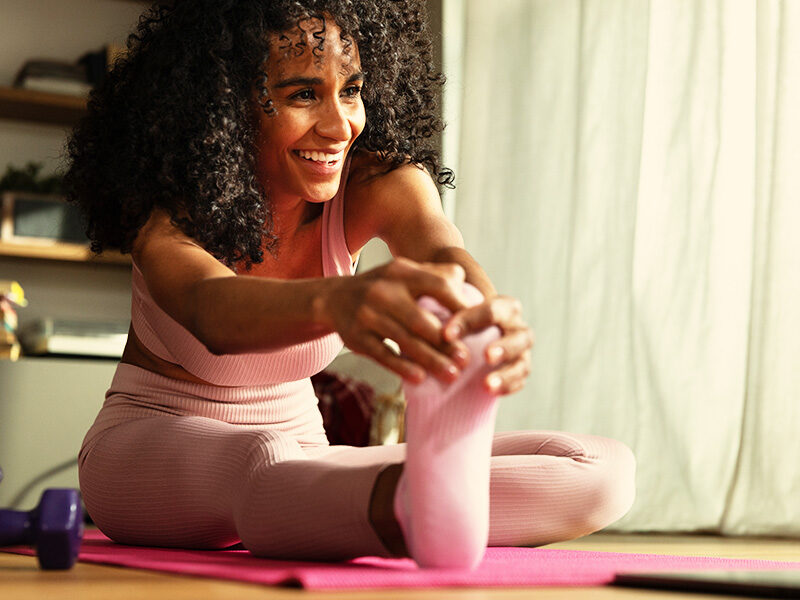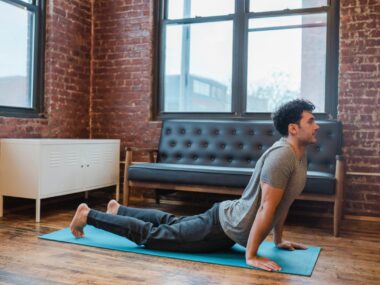In today’s fast-paced world, finding the time and resources to hit the gym can be a challenge. However, maintaining a fitness routine doesn’t require a gym membership. Home workouts offer flexibility, convenience, and the ability to tailor exercises to your specific needs. This guide provides comprehensive tips for creating an efficient fitness routine at home, ensuring you can achieve your health and fitness goals without stepping into a gym.

Benefits of Home Workouts
Convenience:
One of the primary advantages of home workouts is the convenience they offer. With no commute time, you can fit exercise into your schedule more easily. Whether you prefer working out in the morning, during lunch breaks, or late at night, you have the flexibility to choose the time that best suits you.
Cost-Effective:
Home workouts eliminate the need for a gym membership, saving you money. Additionally, you can start with minimal equipment and gradually invest in more as needed. Many effective exercises require no equipment at all, relying on body weight for resistance.
Customization:
At home, you can design a workout routine that caters to your specific goals and preferences. Whether you’re focusing on strength training, cardio, flexibility, or a combination of these, you have the freedom to customize your workouts to fit your needs.
Privacy:
For those who feel self-conscious working out in front of others, home workouts provide a private environment where you can exercise without feeling judged. This privacy can increase your comfort level and help you stay consistent with your routine.
Setting Up Your Home Workout Space
Choose the Right Space:
Select a dedicated area in your home for workouts. It should be spacious enough to allow you to move freely and perform various exercises. Whether it’s a corner of your living room, a spare bedroom, or even your backyard, having a designated workout space helps create a routine and reduces distractions.
Equip Your Space:
While many exercises can be performed without any equipment, having a few basic items can enhance your workouts. Here are some essentials:
- Yoga Mat: Provides cushioning and grip for floor exercises.
- Resistance Bands: Versatile tools for strength training.
- Dumbbells or Kettlebells: Ideal for adding resistance to your workouts.
- Jump Rope: Great for cardio and improving coordination.
- Stability Ball: Useful for core exercises and improving balance.
- Pull-Up Bar: Perfect for upper body strength training.
Maintain an Organized Area:
Keep your workout space clean and organized. Store equipment neatly when not in use to ensure the area is inviting and ready for your next workout. A clutter-free environment can enhance your motivation and focus.
Designing Your Home Workout Routine
Set Clear Goals:
Before starting your home workout routine, define your fitness goals. Whether you aim to lose weight, build muscle, improve endurance, or enhance flexibility, having clear goals will guide your workout plan and keep you motivated.
Create a Balanced Routine:
An effective workout routine should include a mix of strength training, cardio, and flexibility exercises. Here’s how to balance these components:
Strength Training:
Incorporate strength training exercises at least two to three times a week. Focus on major muscle groups, including legs, back, chest, arms, and core. Some effective bodyweight exercises include:
- Squats: Strengthen your legs and glutes.
- Push-Ups: Target your chest, shoulders, and triceps.
- Planks: Engage your core muscles.
- Lunges: Work on your legs and improve balance.
- Burpees: Combine strength and cardio for a full-body workout.
Cardio
Include cardio exercises to improve cardiovascular health and burn calories. Aim for at least 150 minutes of moderate-intensity or 75 minutes of high-intensity cardio each week. Some effective home cardio exercises are:
- Jumping Jacks: Simple yet effective for raising your heart rate.
- High Knees: Great for a cardio burst and leg strength.
- Mountain Climbers: Engage your core and improve cardiovascular endurance.
- Dancing: A fun way to get your heart pumping.
Flexibility
Flexibility exercises help improve your range of motion and prevent injuries. Incorporate stretching or yoga into your routine at least two to three times a week. Some beneficial stretches include:
- Hamstring Stretch: Lengthen the muscles in the back of your legs.
- Chest Opener: Improve flexibility in your chest and shoulders.
- Child’s Pose: Stretch your back and promote relaxation.
- Downward Dog: Enhance flexibility in your hamstrings and calves.
Plan Your Schedule
Create a weekly workout schedule that fits your lifestyle. Consistency is key, so plan your workouts at times that you’re most likely to stick with. Here’s an example of a balanced weekly routine:
- Monday: Strength Training (Upper Body)
- Tuesday: Cardio (HIIT or Steady-State)
- Wednesday: Strength Training (Lower Body)
- Thursday: Flexibility (Yoga or Stretching)
- Friday: Cardio (Dance or Aerobics)
- Saturday: Strength Training (Full Body)
- Sunday: Rest or Light Activity (Walking or Stretching)
Staying Motivated and Consistent
Set Realistic Expectations:
Start with achievable goals and gradually increase the intensity and duration of your workouts. Unrealistic expectations can lead to frustration and burnout. Celebrate small achievements and progress to stay motivated.
Track Your Progress:
Keep a workout journal or use a fitness app to track your progress. Record your exercises, sets, reps, and any changes in your physical condition. Tracking progress helps you stay accountable and motivated.
Find a Workout Buddy:
Having a workout partner can increase motivation and accountability. Whether it’s a family member, friend, or virtual buddy, sharing your fitness journey with someone else can make workouts more enjoyable and consistent.
Mix It Up:
Variety is essential to prevent boredom and plateaus. Change your exercises, try new workout styles, and challenge yourself with different routines. This not only keeps your workouts interesting but also ensures you continue to make progress.
Stay Positive:
Maintain a positive attitude towards your fitness journey. Understand that progress takes time and there will be ups and downs. Focus on the benefits of exercise and how it makes you feel, rather than just the physical outcomes.
Overcoming Common Challenges
Limited Space:
If space is a constraint, opt for exercises that require minimal room. Bodyweight exercises, resistance band workouts, and high-intensity interval training (HIIT) are excellent options. You can also utilize furniture like chairs or stairs for added variety.
Lack of Equipment:
You can achieve a full-body workout with little to no equipment. Bodyweight exercises, household items (like water bottles as weights), and creative use of furniture can substitute for traditional gym equipment. Investing in versatile equipment like resistance bands can also be a cost-effective solution.
Time Constraints:
If you’re short on time, focus on high-intensity workouts that provide maximum benefit in a shorter period. HIIT workouts, circuit training, and tabata routines are effective for quick, intense sessions. Even a 20-minute workout can be highly effective if done consistently.
Staying Motivated Alone:
Working out alone can sometimes be challenging. To stay motivated, set specific, measurable goals, create a motivating workout playlist, join online fitness communities, or follow along with virtual workout classes.
Utilizing Online Resources
Fitness Apps:
There are numerous fitness apps available that provide guided workouts, progress tracking, and personalized plans. Some popular apps include:
- Nike Training Club: Offers a variety of workouts and training plans.
- MyFitnessPal: Tracks your diet and exercise, providing insights into your fitness journey.
- FitOn: Provides free workouts led by celebrity trainers.
Online Workout Videos:
Platforms like YouTube offer a plethora of free workout videos catering to all fitness levels and preferences. Channels like Fitness Blender, Yoga with Adriene, and HASfit provide a wide range of exercises and routines.
Virtual Classes:
Many fitness studios and trainers offer virtual classes, allowing you to participate in live or on-demand workouts from the comfort of your home. This option provides the structure and motivation of a class environment.
Listening to Your Body
Avoid Overtraining:
While it’s important to stay consistent, overtraining can lead to injuries and burnout. Listen to your body and incorporate rest days into your routine. If you’re feeling excessively sore or fatigued, take a break or opt for a lighter workout.
Proper Warm-Up and Cool-Down:
Always start your workouts with a proper warm-up to prepare your body and reduce the risk of injury. A good warm-up includes dynamic stretches and light cardio to increase blood flow. Similarly, end your workout with a cool-down session, including static stretches to aid recovery and improve flexibility.
Hydration and Nutrition:
Staying hydrated and maintaining a balanced diet are crucial for optimal performance and recovery. Drink plenty of water before, during, and after your workouts. Fuel your body with a mix of carbohydrates, protein, and healthy fats to support your fitness goals.
Conclusion
Creating an efficient fitness routine at home is entirely feasible with the right approach and mindset. By setting clear goals, designing a balanced routine, and utilizing available resources, you can achieve your fitness objectives without a gym. Remember, consistency and patience are key
to making progress. Celebrate your achievements, no matter how small, and stay committed to your health and fitness journey. With dedication and the right strategies, home workouts can be just as effective, if not more so, than traditional gym sessions.










